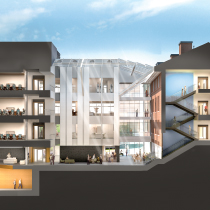 |
 |
||||||||||||||
 |
| Rendering: ©Payette |
Designed for Collaboration
New science building will seed innovation across the universityThe study and practice of science is about to get even better at Tufts. The Science and Engineering Complex, a gleaming five-story, glass-and-brick building scheduled to open in 2017 on the Medford/Somerville campus, will foster collaboration among scientists and engineers from different departments and serve as the anchor for Tufts’ emerging Science and Technology Corridor that extends south along Boston Avenue.
The building, known as the SEC, is under construction on a parcel of land that fronts Dearborn Road, behind Anderson and Robinson halls. Faculty will use it to collaborate on selected research themes in lab space designed to accommodate new areas of inquiry as they arise.
“The SEC will be the first Tufts-owned building in which students and faculty from different disciplines will share laboratory space, a concept that is being used more and more on campuses,” says Diane Souvaine, vice provost for research. “Research done collaboratively by people from different fields and areas of expertise can be particularly fruitful.” The 80,000-square-foot center will feature state-of-the art research and teaching labs. Two inaugural research themes have been chosen: environmental science and neuroscience.
The SEC will be the gateway to other research and learning facilities along Boston Avenue, like the Collaborative Learning and Innovation Complex (CLIC), opened this spring, and the Science and Technology Center, the psychology department, and Bromfield-Pearson, which houses mathematics.
The SEC and CLIC are in keeping with trends in education and research at major universities, says President Anthony P. Monaco, a geneticist. “Strong individual disciplines, brought together by collaboration and interaction, offer the best potential for discoveries that address a wide range of human and environmental concerns,” he says. “It is through working together—and socializing in the bright new spaces in these buildings—that interaction and exciting innovation can occur.”
The Science and Engineering Complex will also be one of the most energy-efficient buildings of its kind in the country and serve as a model for sustainability standards for mechanical, electrical, and plumbing systems, says Michael Skeldon, the project manager. The goal is to receive LEED (Leadership in Energy and Environmental Design) certification from the U.S. Green Building Council, which recognizes best-in-class environmental strategies and practices.
Barbara Stein, the university’s director of strategic capital programs, says she is excited by the transformation of the area, which will also be the terminus for the planned expansion of the MBTA’s Green Line, minutes away from the Science and Technology Corridor.
“When it is completed, Tufts will be on the cutting edge of how research is being done,” she says.
To learn about naming opportunities and other ways you can support the Science and Engineering Complex and the Collaborative Learning and Innovation Complex, contact Jo Wellins, executive director of University Advancement, at jo.wellins@tufts.edu or 617.627.5906.